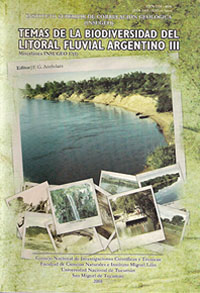Miscelánea 17 (1)
Hormigas Coloradas (Solenopsis invicta;Hymenoptera: Formicidae) en Nidos de Yacaré Overo (Caiman latirostris; Crocodylia: Alligatoridae) ¿Aleatorio o Elección?
María Virginia Parachú Marcó | Carlos Ignacio Piña
Descargar trabajo en formato PDFResumen
HORMIGAS COLORADAS (SOLENOPSIS INVICTA; HYMENOPTERA: FORMICIDAE) EN NIDOS DE YACARÉ OVERO (CAIMAN LATIROSTRIS; CROCODYLIA: ALLIGATORIDAE) ¿ALEATORIO O ELECCIÓN? Solenopsis invicta se reproduce durante la mayor parte del año, sobre todo en los meses cálidos, coincidiendo con la reproducción de varias especies de reptiles. Los hormigueros se construyen generalmente en áreas soleadas abiertas y en ambientes recientemente modificados. En América del Norte esta especie de hormiga utiliza los nidos de caimán americano para establecer sus nuevas colonias; y en nuestra región utiliza los nidos de yacaré overo. Se cree que las Solenopsis invicta son atraídas por la fuente de proteínas, azúcares, lípidos que estos nidos representan, y por la humedad existente en ellos; además muchas veces proporcionan protección contra las inundaciones en ambientes pantanosos. Este estudio analiza la colonización de hormigas coloradas, en condiciones naturales, en nidos de yacaré overo en los ambientes: embalsado, sabana y monte, donde este reptil nidifica, y su relación con la cantidad de hormigueros en esos ambientes. La presencia de hormigueros de S. invicta fue similar entre ambientes. Probablemente, estas hormigas no seleccionen entre ambientes para su colonización, haciéndolo de manera aleatoria, sin embargo encontramos una mayor preferencia de colonización en nidos de embalsados. Concluimos que las hormigas aprovecharían estos lugares altos como resguardo de las lluvias producidas durante el período estival, donde previo a su filtración a través de la vegetación flotante, permanece sobre ella, a diferencia de los demás ambientes donde la misma drena rápidamente.
Abstract
RED FIRE ANTS (SOLENOPSIS INVICTA; HYMENOPTERA: FORMICIDAE) IN BROADSNOUTED CAIMAN (CAIMAN LATIROSTRIS; CROCODYLIA: ALLIGATORIDAE) RANDOM OR ELECTION? Solenopsis invicta has a longer reproduction period than other ants, happening in some regions during most of the year, mostly in the warm months, coinciding with reptiles reproduction. The red fire ant (RFA) nests are generally constructed in open sunny areas and habitats recently modified. In North America this ant also uses Alligator nests to establish new colonies; and in our region uses caiman nests. RFAs are attracted to caiman nests because they provide a source of proteins, sugars, lipids and humidity; also they would protect the colony from flooding in the floating vegetation. This study analyse the presence of RFA in caiman nests in natural conditions in three nesting habitats, floating vegetation, savanna, and forest; related to the amount of RFA nests in those habitats. The presence of ant nests of S. invicta was similar between different habitats. Probably, ants do not select between habitats to colonize, doing it randomly, nevertheless we found greater preference to colonize floating vegetation nests. We concluded that the ants would take advantage of high places like defense against rains produced during the summer period, where previous to its filtration through the floating vegetation, remains on its, unlike other habitats where it drains quickly.






